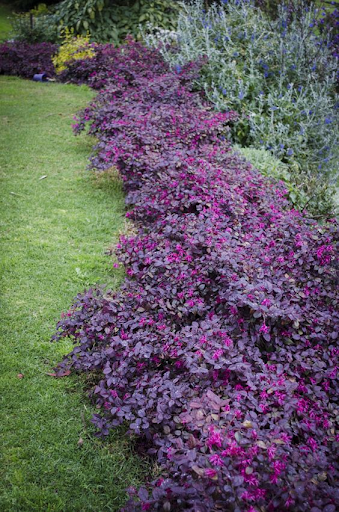The Loropetalum, also known as the Chinese Fringe Flower, is a stunning plant that grows in a wide variety of colors and sizes. Though native to Japan, China, and the Himalayas, the Loropetalum can be found in many regions of the USA, because of its striking beauty and ability to thrive in a range of conditions, making it a favorite of American gardeners. The Loropetalum blooms mostly in the Spring, bringing a vibrant splash of color to any garden or yard.

How Big Do Dwarf Loropetalum Get
The Loropetalum can typically reach heights of 12 to 15 feet tall. Some 100-year-old specimens are 35 feet tall! The Dwarf Loropetalum is on the small side, ranging from 2 to 6 feet tall. The white Dwarf Loropetalum varieties have plush white flowers on green foliage, while the purple variants bloom flowers ranging from soft pink to a deep dark purple, and even a feisty red.
How to Plant My Loropetalum
To ensure your Loropetalum grows into a plant you can be proud of, you must plant it properly. Dig a hole twice as large as the container it comes in and gently place your plant into the hole. Cover with soil, and water generously to give your plant a boost. Your Loropetalum will thrive much better with mulching. Be sure to surround the plant with well-rotted mulch, which will maintain the soil temperature.
What to Feed My Loropetalum
Loropetalum love the sun, but they are not asking for a tan, so they need partial shade as well. The ideal treatment for the Loropetalum is for it to get morning sun, and then shade in the afternoon. Keep the sun’s direction in mind when deciding where you want to plant your new Loropetalum. The Loropetalum does not require a lot of watering and can be very resistant to drought when established. Water your Loropetalum twice a week to keep it fresh. To stimulate growth, Loropetalum can be given fertilizer twice a year, which is best done by lightly applying slow-release fertilizer in early April, and again in mid-May. A balanced 10-10-10 granular fertilizer mixed into the soil at the plant’s root zone will have the best effect.
Problems Loropetalum Might Face
A soil that has a pH level above 7 is not healthy for your Loropetalum. If your soil is too alkaline, it might cause the leaves to be chlorotic and start to appear yellow or brown. If your soil is alkaline, you may apply granular Sulphur, cottonseed meal, or peat moss to make the soil more conducive for the Loropetalum. The elegant Loropetalum thrives best in USDA zones 9a – 10b. Loropetalum also thrives in well-drained, acidic soil with a lot of organic matter. Too much intense heat or too much shade is also bad for the color of your Loropetalum. Leaves that are supposed to appear purple may begin to turn green, yellow, or even brown due to too much heat.
The Loropetalum is a decently resilient plant and is mostly not susceptible to pests and diseases. However, even Superman has his kryptonite, so we can forgive the Loropetalum for not being entirely invincible. Where the soil is not properly drained, your Loropetalum may be susceptible to root rot. Take care of pruning after the spring flush of flowers so it does not affect the next blossom.

Loropetalum: A Winner for Your Yard
Loropetalum are easy-care landscape sensations grown easily in clusters, mixed screens, as foundational plantings like hedges, bonsai, or single specimens. They also make a beautiful choice when combined with other plants to create your own landscaping masterpiece. Their signature purple-leaf works wonderfully with other green foliage plants. Your neighbors will be asking for the name!